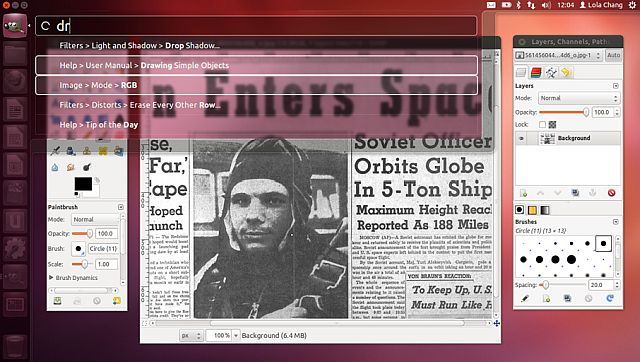Between Windows and Linux builds, I use each equally. This is partially because I’m a developer and also because Linux allows me to fully customize its desktop environment to meet my needs. This is pretty much the main reason people use Linux aside from the fact the OS is a lightning-fast open-source OS which continuously focuses on improving usability and functionality with every build and is constantly updated significantly. However, rather than changing core elements of usability and functionality, canonical has decided to focus more on simplifying the effort of finding files in a number of unique ways in the latest build released last month.
Introducing the HUD
The HUD is essentially a simplistic command feature which will tell your computer what to do. This can be used for anything such as finding or opening a file, to typing out commands that you would normally do in a terminal. It simply makes things a lot easier because if there’s one thing that annoys users about computing, it’s losing track of files.
Tapping the Alt key brings up the HUD on any interface and the HUD adapts itself to whatever program or environment it is in. So if you were editing a photo, and wanted to apply a certain filter or effect to the image but didn’t know where to look from within the application’s menus, the HUD would save time by offering them on the spot.

The HUD is the first truly innovative feature that I have seen in a long time. I’m genuinely starting to enjoy using Ubuntu 12.04 a lot more than my Windows 8 build in certain aspects. The HUD definitely makes the Linux experience within Ubuntu more intuitive.
The Video Lens
The Video Lens is an application which puts itself in the situation where it’s essentially a media station for videos. This media station has its own search feature which doesn’t only find local videos stored on your computer, but also finds whatever video you want to watch online, so for example; if I wanted to watch Top Gear, I could do that and the video would stream directly from BBC iPlayer.
This is a decent feature because personally, I really dislike a lot of Linux’s media players. I just find them a little temperamental, but this however, feels like a solid built-in feature with a lot of potential.

One thing I’d like to see incorporated into The Video Lens is the ability to search for videos on Netflix and other premium streaming sites – it would just make the whole experience somewhat better, in my opinion. However, that would require licensing from Netflix and other services, so whether or not the company would do that is completely beyond me.
The software center
In all fairness; this isn’t a new feature entirely, however, the software center for Ubuntu has been revamped significantly to allow some efficiency between new Linux users and users who have Ubuntu installed on multiple machines. The Ubuntu Software Center still gives users instant access to thousands of apps. users can see the top-rated apps, compare apps by rating and user reviews, keep track of what they've installed, and are able to sync apps between all of the user’s Ubuntu computers.

Although this is a small improvement to what the application offered previously on earlier builds, Canonical stresses that it wants to make Ubuntu more intuitive and the software center is as intuitive as it gets. The software center itself does look a lot more appealing and along with the HUD, most applications can be found, installed or uninstalled without much effort from the user.
Ubuntu could change the way OS’ are created in future
Canonical has built this open-source operating system for years, and to some extent, it is on-par to the performance seen in other operating systems, but it simply lacks a lot of authentic applications such as the Adobe suite. If you exclude that minor bump in the road that is Ubuntu, you’ll find it’s smoother and faster than any current OS – including my PC with the Windows 8 consumer preview.
Ubuntu stresses upon the fact that it wants to be the best desktop environment currently available rather than being just another forceful push towards the tablet division. The OS is minimizing the physical effort a user may give throughout the OS’ experience, but at the same time offers a really intuitive design which screams, “play with me”.
Bash me in the comments section below (if you will), but I truly believe that instead of shoving an OS like Windows 8 down our throats, that developers should focus on creating an experience which meets all user types – that’s fundamental in designing interaction. I would just rather use something I’m experienced enough to understand and I hope developers focus on enhancing core desktop environments and not focus on almost cross-platform OS’.
I personally find a Windows 8 installation irrelevant to anything other than a touch-enabled device, but with Ubuntu, I do not have to worry about that, and the best part about this experience was the obvious – it was free. Linux builds have long been predicted to exceed the standards Windows and Mac OSX offers for the past decade, but maybe focusing on core desktop environments is exactly what Canonical needs to do in order to win over the crowd that supports Microsoft and Apple's OS'.














112 Comments - Add comment